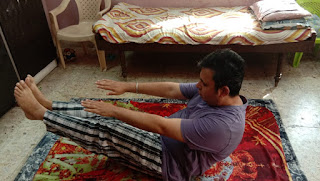Breathing Exercise - How to do Complete Yogic Breathing and Its Advantages
 |
| Complete Yogic Breathing |
Image by Dean Moriarty from Pixabay
Life is completely dependent on the breath; all living things, including plants, must have air to live. Breath is always present, from the moment a baby fills its lungs, to the last gasp of a dying man. A Hindu proverb says ‘Life is nothing but a series of breaths’.
While we may live without eating for many days, and without drinking for many hours, how many minutes can we last without breathing? Man must not only breathe to live, but should do so in such a way that he maintains constant vitality and avoids illness.
Unfortunately, the number of people who know how to breathe properly is very limited. Most people breathe in a very haphazard way as may be seen by cramped chests, stooping shoulders and the development of respiratory illnesses. It has been observed that improper breathing habits decrease resilience and shorten life.
Whether they know it or not, some people breathe from the clavicle (the upper part of the chest), others from the thorax, and a third group from the diaphragm.
This type of breathing is incomplete, for only one part of the lungs is filled with air. Research made in India by various Yoga institutes has shown that these kinds of breathing do not provide man with uniform development, whether physical, mental or spiritual.
The Yogis declare the three types of breathing is the basis for all breathing exercises (Pranayama).
Complete Yogic breathing consists of three parts:
- Abdomen
- Middle part of the chest (thorax)
- Upper part of the chest or collar bones (clavicle)
We shall examine each of the three types of breathing separately.
Note: One should always inhale and exhale through the nose. The small screen of hair inside the nose not only filters the air, but also prevents impurities such as dust, harmful gases, minute insects, etc., from penetrating into the organism.
As per a Hindu saying: “The nose is to breathe, the mouth is to eat and to speak wherever necessary.” “Unfortunately, the number of people who know how to breathe properly is very small.”
Breathing from the Abdomen
The easiest method is to put the hands lightly on the abdomen so that its movements may be felt.
During inhalation, the abdomen should be allowed to expand a little, like a bow, as the lower parts of lungs fills with air. During exhalation the abdomen is allowed to sink in again. It can be done standing, sitting or lying on one’s back.
Advantages of Abdomen Breathing
- This is a great internal massage for all the abdominal organs.
- It regularizes the functioning of the intestines and stimulates the digestion.
Breathing from the middle part of the chest (Thorax)
Put the hands on either side of the ribs without pressing. Inhale slowly inflating the sides, and then contract them by exhaling, like an accordion. Repeat several times. It can be done standing, sitting or lying on one’s back.
Advantages
- Purifies the blood, improves circulation and calms the heart.
Breathing from the Upper Part of the Chest
Put the hands on each side of the clavicle (upper chest) touching it with the fingers. Contract the stomach slightly. Inhale slowly pushing the clavicle upwards, then being to exhale pushing it downwards. This exercise should also be repeated several times.
This exercise can be done standing, sitting or lying on one’s back.
Advantages
Thoroughly cleans and fortifies the upper chest.
Complete Yogic Breathing
In complete Yogic breathing, we combine abdominal, middle and upper parts of the chest in a wave like movement. After exhaling completely we begin to inhale, letting the abdomen come out a little, and filling the lower part of the lungs, then expanding the ribs, whilst slightly drawing in the stomach until finally we fill the top part of the lungs.
In Sanskrit “Puraka” means ‘inhalation’. Exhalation (Rechaka) begins with abdomen being drawn in; then the ribs are contracted, and finally the collar bone lowered, thus completely emptying the lungs.
The whole process of inhaling and exhaling should be done as one smooth, continuous movement, like a wave, and the volume of breath while inhaling should be the same.
To begin with, it is quite difficult to breathe with this gentle, continuous movement. Once the habit has been acquired this wave-like breathing will come almost naturally. With a little patience and perseverance the desired results will be achieved.
Advantages of Yogic Breathing
Complete Yogic breathing is of importance to all those men, women or children who wish to enjoy good health.
We should bear in mind that exercise of the external muscles is not all that is required. The internal organs also need exercise, and this is why complete Yogic breathing should be regarded as a gift.
Let us take for example the role of the diaphragm. Every movement of the respiratory organs make those of nutrition and digestion vibrates, whilst supplying a larger quantity of blood to invigorate and massage various organs. If they are not treated in this way, they will remain sluggish and refuse to function properly. Deficient movement of the diaphragm is the cause of many illnesses.
Complete Yogic breathing brings all of the respiratory organs into play, guards against pulmonary infections in general, and is very important in preventing asthma and heart trouble. It helps in maintaining the individual’s perfect health. It can, revive the body when completely exhausted, or calms both mind and nervous system.
Similarly, Yogic breathing exercises are intended to help accumulate Prana. It is possible, not only to increase the quantity of Prana absorbed by deep and regular inhalation, but also to consciously direct it by exhalation to all parts of the body. So animating the latter a much greater supply of oxygen is thus brought into the bloodstream.
This way the vital organs, endocrine glands, nervous centres and body tissues are better nourished.
Abundant absorption of Prana calms the nervous system. Heartbeats become regular and the lungs are thoroughly aired. We are filled with a feeling of mental and physical peace.
Also Read: Breathing Exercise - How to do Rhythmic Breathing and its Benefits
Also Read: Breathing Exercise - How to do Rhythmic Breathing and its Benefits



Comments
Post a Comment